The Samaria Gorge is the most famous trekking gorge in Europe and a part of the European E4 hiking trail. Thousands of tourists flock here daily in the summer season to walk from the top to the bottom. For many visitors, it is the sole purpose of their visit to Crete. The length of the gorge reaches 14.5km and takes almost 5-7 hours to hike from Xyloskalo at Omalos plateau to Agia Roumeli, depending on the trekking pace.
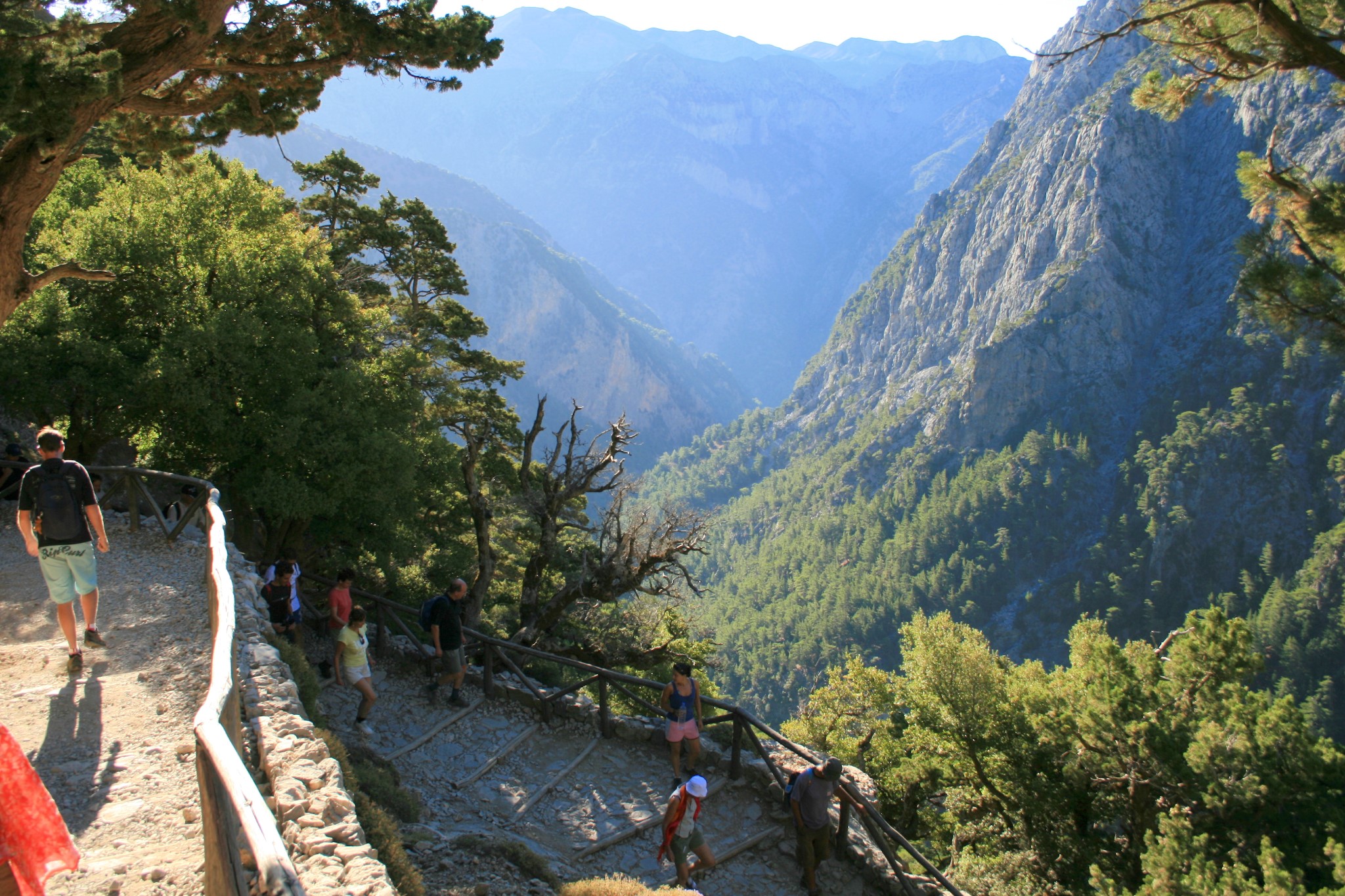 Initially we descend from Xyloskalo to the riverbed of Samaria GorgeThe gorge is locarted at the south of Chania Prefecture in the larger uninhabited area of Europe, where no roads even exist. It was created by the river flowing between the main massif of the White Mountains (Lefka Ori) and the range of Volakias. There are many smaller gorges vertical to Samaria Gorge, some of which have never been crossed by humans and require canyoning equipment. One of these, Perdika, has the highest waterfall in Crete (220m).
Initially we descend from Xyloskalo to the riverbed of Samaria GorgeThe gorge is locarted at the south of Chania Prefecture in the larger uninhabited area of Europe, where no roads even exist. It was created by the river flowing between the main massif of the White Mountains (Lefka Ori) and the range of Volakias. There are many smaller gorges vertical to Samaria Gorge, some of which have never been crossed by humans and require canyoning equipment. One of these, Perdika, has the highest waterfall in Crete (220m).
 There are many fresh-water springs along the route. Water is potableWhile the gorge is officially 15km long, this distance actually refers to the hiking distance between the settlement of Omalos on the northern side of the plateau Omalos and the village of Agia Roumeli. In fact, the gorge is 13 km long, starting at an altitude of 1,250m at the northern entrance, and ending at the shores of the South Cretan Sea in Agia Roumeli. The walk through Samaria Natural Park is 13 km long, i.e. from the ticket kiosk at Xyloskalo to the kiosk at Agia Roumeli old village, but you have to walk 1.5 more kilometers to reach the beach of Agia Roumeli, making the hike totally 14.5km.
There are many fresh-water springs along the route. Water is potableWhile the gorge is officially 15km long, this distance actually refers to the hiking distance between the settlement of Omalos on the northern side of the plateau Omalos and the village of Agia Roumeli. In fact, the gorge is 13 km long, starting at an altitude of 1,250m at the northern entrance, and ending at the shores of the South Cretan Sea in Agia Roumeli. The walk through Samaria Natural Park is 13 km long, i.e. from the ticket kiosk at Xyloskalo to the kiosk at Agia Roumeli old village, but you have to walk 1.5 more kilometers to reach the beach of Agia Roumeli, making the hike totally 14.5km.
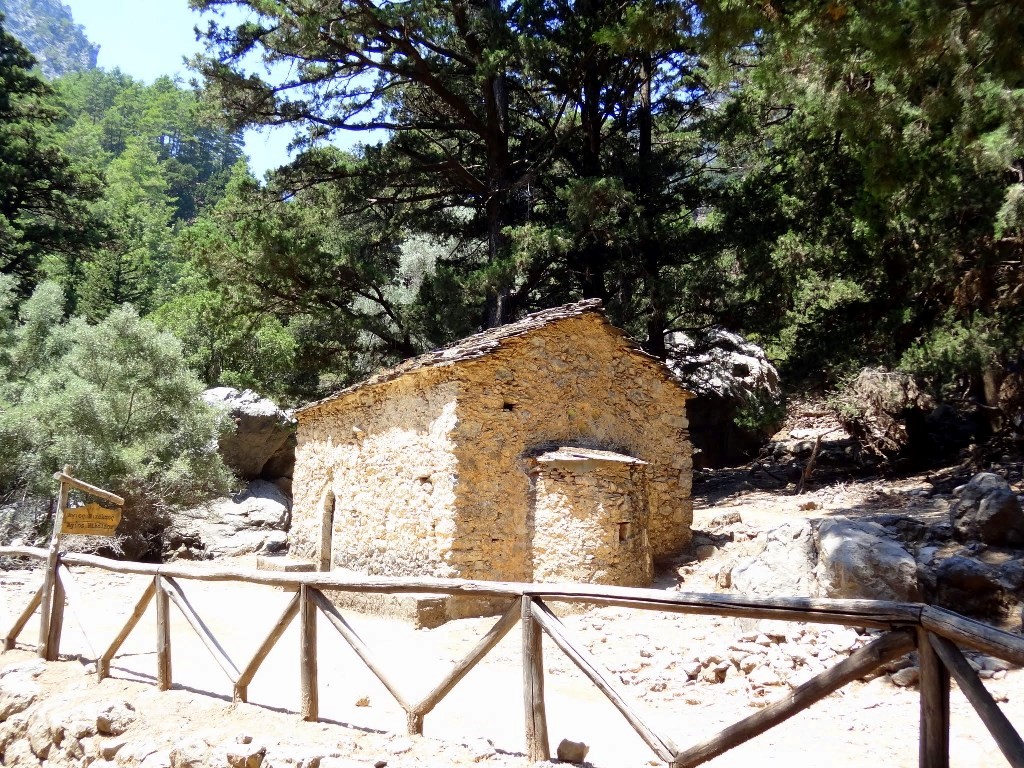 Saint Nicholas chapelThe most famous part of the gorge is the stretch known as the Iron Gates (Sideroportes), where the sides of the gorge close in to a width of only four meters and soar up to a height of 500 m. The gorge became a national park in 1962, particularly as a refuge for the rare Cretan ibex, which is today restricted to the Lefka Ori National Park, the island Thodorou and several more islets. There are several endemic species of fauna and flora in the gorge and surrounding area.
Saint Nicholas chapelThe most famous part of the gorge is the stretch known as the Iron Gates (Sideroportes), where the sides of the gorge close in to a width of only four meters and soar up to a height of 500 m. The gorge became a national park in 1962, particularly as a refuge for the rare Cretan ibex, which is today restricted to the Lefka Ori National Park, the island Thodorou and several more islets. There are several endemic species of fauna and flora in the gorge and surrounding area.
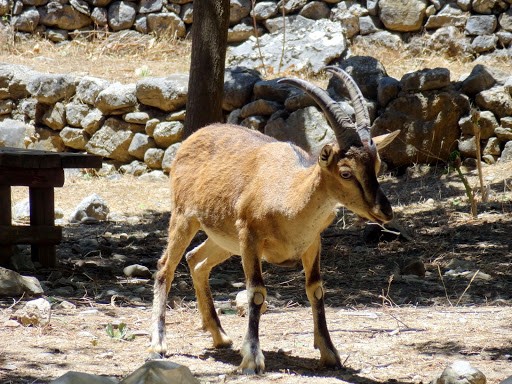 Cretan Ibex: the famous resident of the gorgeThe desert village of Samaria lies just inside the gorge. It was finally abandoned by the last remaining inhabitants in 1962 to make way for the park. The village and the gorge is believed to take their names from the village's old church of Mary of Egypt (Osia Maria).
Cretan Ibex: the famous resident of the gorgeThe desert village of Samaria lies just inside the gorge. It was finally abandoned by the last remaining inhabitants in 1962 to make way for the park. The village and the gorge is believed to take their names from the village's old church of Mary of Egypt (Osia Maria).
 The abandoned village of SamariaA "must" for visitors to Crete is to complete the walk down the gorge from the Omalos plateau to Agia Roumeli on the South Cretan Sea. From there the most visitors get the ferry to the port of Chora Sfakion and catch a coach back to Chania. The walk takes 4-7 hours and can be strenuous, especially at the peak of summer.
The abandoned village of SamariaA "must" for visitors to Crete is to complete the walk down the gorge from the Omalos plateau to Agia Roumeli on the South Cretan Sea. From there the most visitors get the ferry to the port of Chora Sfakion and catch a coach back to Chania. The walk takes 4-7 hours and can be strenuous, especially at the peak of summer.
When to come
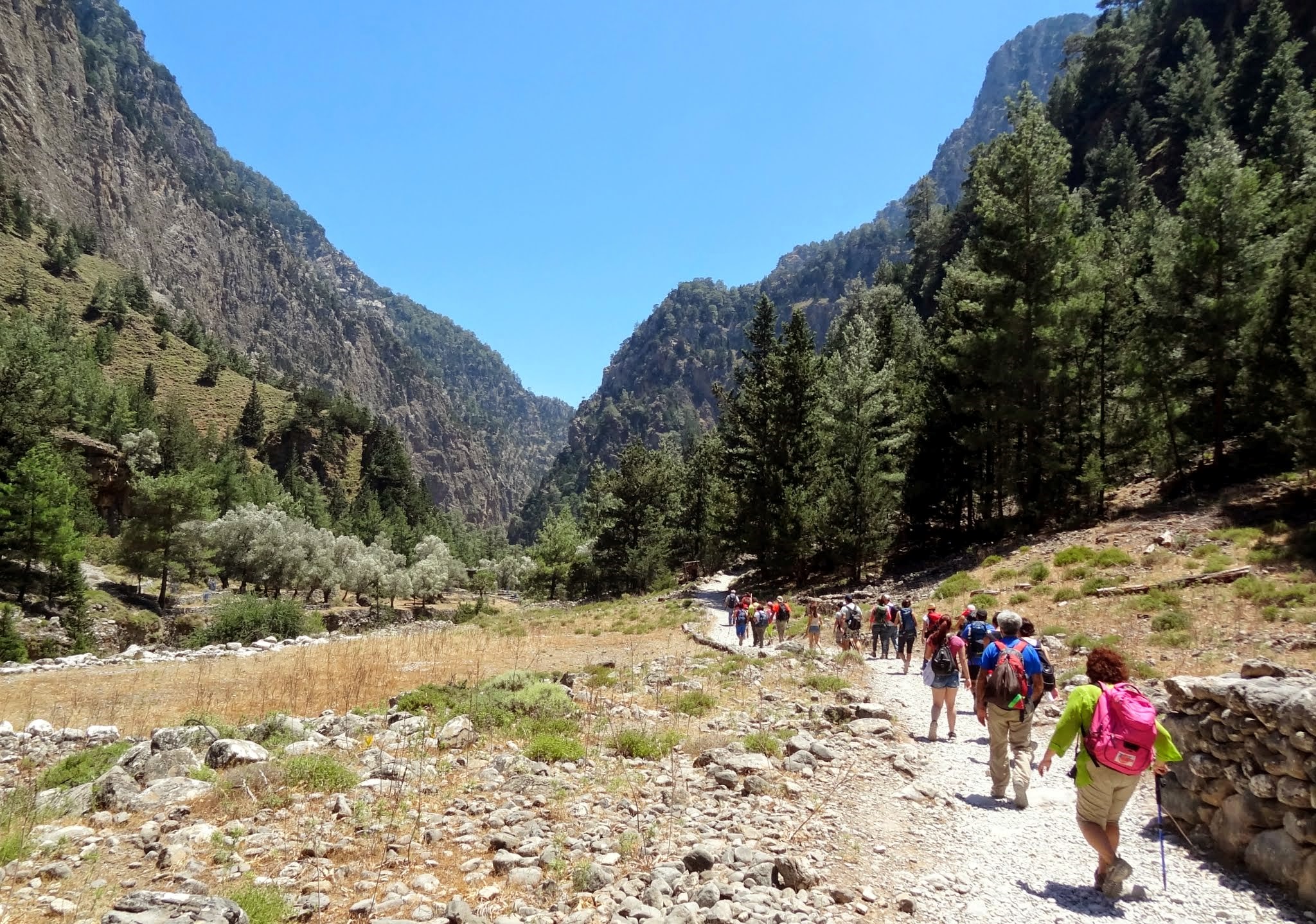
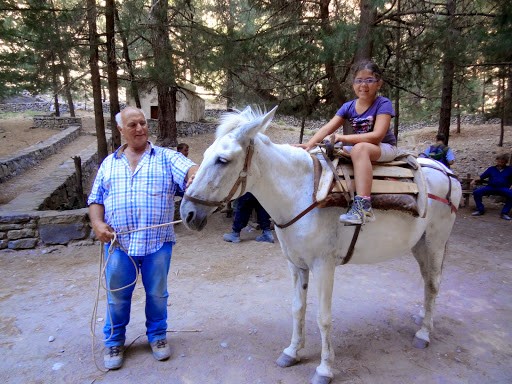 Donkeys are the only mean of transportAs far as the times of the year are concerned, the best time is spring: the weather is still cool and the vegetation is at its best. The worst time is in the middle of the summer during a heat wave. Give it a miss and come again at a better time.
Donkeys are the only mean of transportAs far as the times of the year are concerned, the best time is spring: the weather is still cool and the vegetation is at its best. The worst time is in the middle of the summer during a heat wave. Give it a miss and come again at a better time.
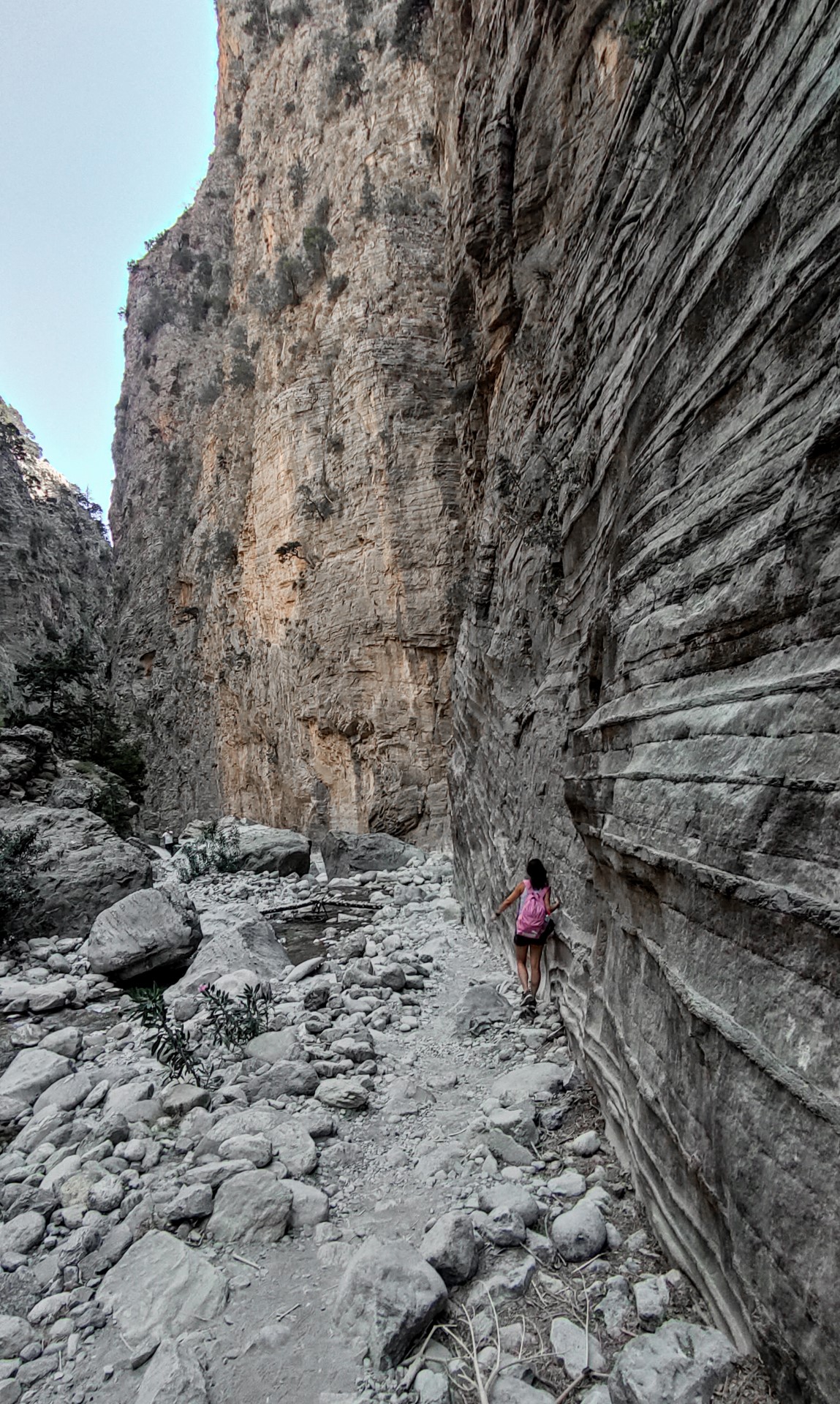 Amazing Rock FormationsAll local tourist operators in Crete provide organized tours to the gorge. These include bus transportation from your hotel to the entrance (near Omalos village), and the bus will be waiting for you to disembark the ferry in Chora Sfakion to take you back. If you are on your own, you can make a one-day round trip from Chania or from Sougia or Paleochora. Note that the morning buses from Sougia and Paleochora do not operate on Sunday, but still make sure that you know the timetables. The ferries leave Agia Roumeli to Chora Sfakion (east-bound) and to Sougia/Paleochora (West-bound) at afternoon.
Amazing Rock FormationsAll local tourist operators in Crete provide organized tours to the gorge. These include bus transportation from your hotel to the entrance (near Omalos village), and the bus will be waiting for you to disembark the ferry in Chora Sfakion to take you back. If you are on your own, you can make a one-day round trip from Chania or from Sougia or Paleochora. Note that the morning buses from Sougia and Paleochora do not operate on Sunday, but still make sure that you know the timetables. The ferries leave Agia Roumeli to Chora Sfakion (east-bound) and to Sougia/Paleochora (West-bound) at afternoon.
There also exists a "lazy way" - from Agia Roumeli to the Iron Gates (more or less an hour of non-challenging terrain) and back.
The course from Xyloskalo
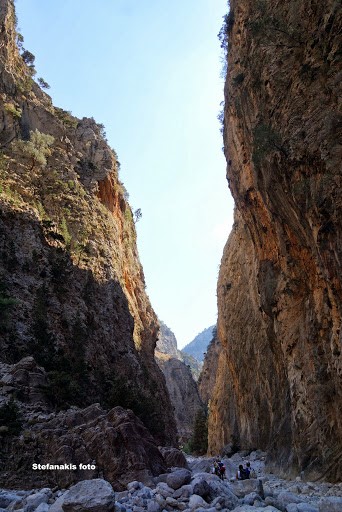 Sideroportes (Iron Gates)Descent in the canyon starts from the position Xyloskalo at Omalos Plateau, at an altitude of 1200m, where you have to pay a small entrance fee for the protection of the reserve. The trail is wooded with cypress and pine trees, wide and very well discernible, while at the beginning descends abruptly. We meet drinking water and toilets very often. In about three hours we reach the old village of Samaria, at an altitude of about 300 meters, after crossing by the church of Saint George.
Sideroportes (Iron Gates)Descent in the canyon starts from the position Xyloskalo at Omalos Plateau, at an altitude of 1200m, where you have to pay a small entrance fee for the protection of the reserve. The trail is wooded with cypress and pine trees, wide and very well discernible, while at the beginning descends abruptly. We meet drinking water and toilets very often. In about three hours we reach the old village of Samaria, at an altitude of about 300 meters, after crossing by the church of Saint George.
In Samaria there are old houses, trees offering shade, water springs and if you are lucky you will meet the endangered Cretan wildgoat. From here onwards the landscape changes, becomes drier and the slope gets smooth. One hour later we walk along the riverbed for some time. There are several small wooden bridges in several places, above the river.
After one more hour we meet the imposing Sideroportes (Iron Gates) which is a very narrow passage between two tall vertical 500m high cliffs. We soon reach the old village of Agia Roumeli that was abandoned in the mid 1900s due to a devastating flood and was moved to the seaside settlement of Agia Roumeli, which is about 30 minutes away.
Operates May 1 - October 31, opens daily at 7:00
(Sometimes, due to bad weather the gorge remains closed, so its a good idea to call +30 2821067179 before coming)
What is near me?
Additional Info
- Length (km): 18
- Type: Hiking gorge, Signed trail, E4 trail
- Location: Chania Prefecture
- Water: Water all year round, Springs
- Difficulty (0-10): 2
- Altitude difference (m): 1200
- Hiking Hours: 6
- Accessibility: Bus services, Paved road, Boat
- Entrance Fee (€): 5










 Samaria Gorge
Samaria Gorge 
-502df35080.jpg)















-27905d5b94.jpg)





















































































